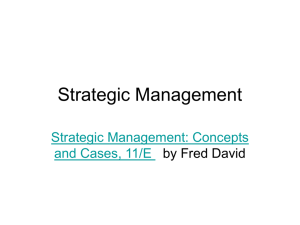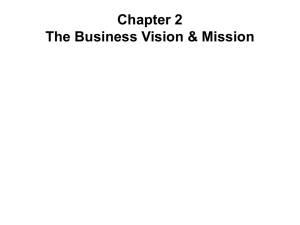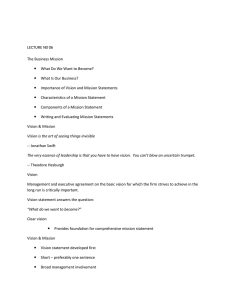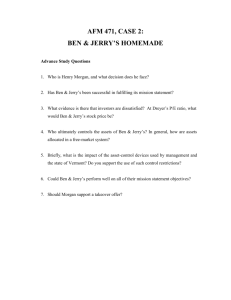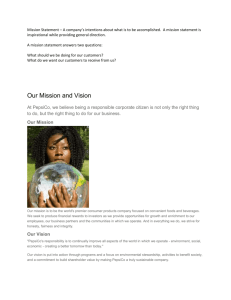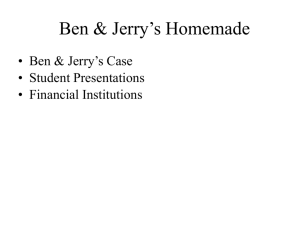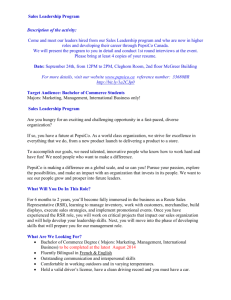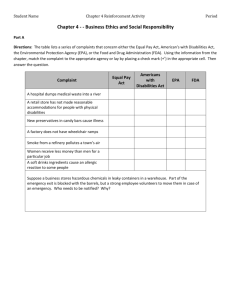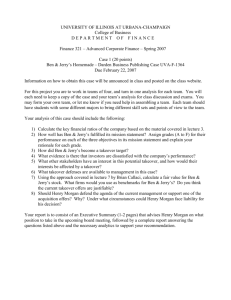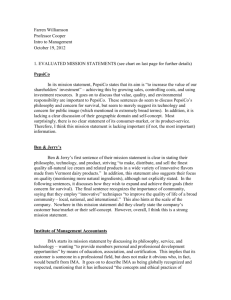Vision & Mission
advertisement
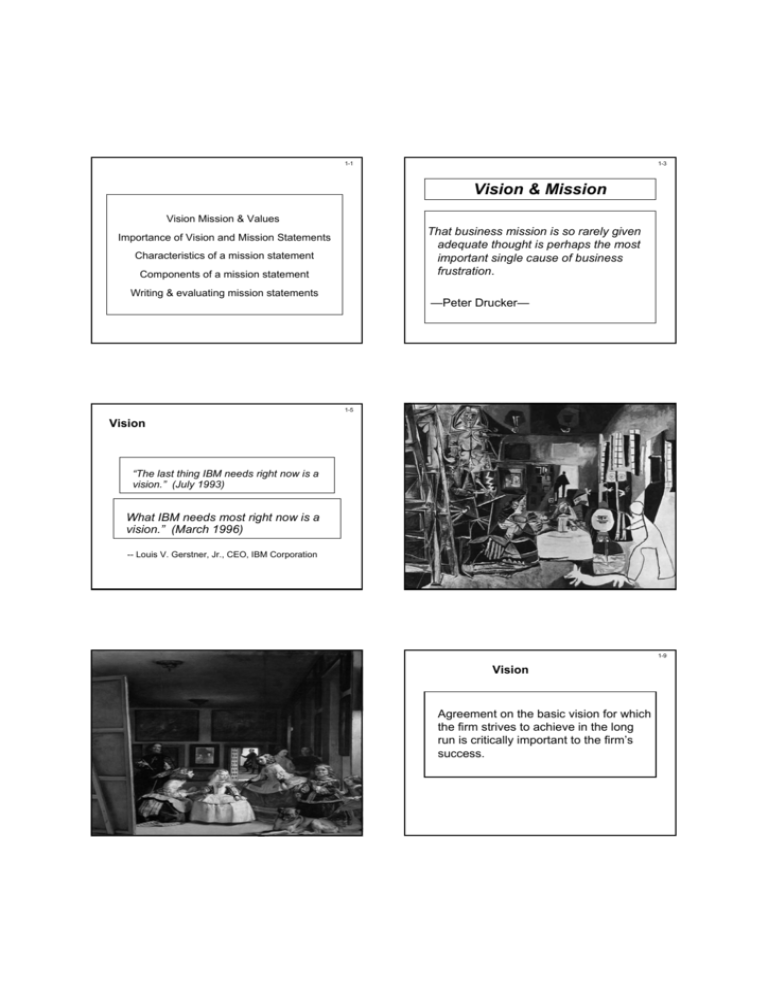
1-1 1-3 Vision & Mission Vision Mission & Values That business mission is so rarely given adequate thought is perhaps the most important single cause of business frustration. Importance of Vision and Mission Statements Characteristics of a mission statement Components of a mission statement Writing & evaluating mission statements —Peter Drucker— 1-5 Vision “The last thing IBM needs right now is a vision.” (July 1993) What IBM needs most right now is a vision.” (March 1996) -- Louis V. Gerstner, Jr., CEO, IBM Corporation 1-9 Vision Agreement on the basic vision for which the firm strives to achieve in the long run is critically important to the firm’s success. 1-10 1-11 Important Components of Organizational Vision SPECIFIC QUESTIONS THAT HELP FORM STRATEGIC VISIONS • • • • • What business are we in now? What business do we want to be in? What will our customers want in future? What are expectations of our stakeholders? Who will be our future competitors? suppliers? partners? • What should our competitive scope be? • How will technology impact our industry? • What environmental scenarios are possible? Summary of What Organization Does Organizational Purpose Broad Goals Core Values and Beliefs 1-12 Values Dimensions of Organizational Culture Stability The values of a person or group are the moral principles and beliefs that they think important in life and that they tend to live their lives by. Aggressiveness People Orientation Innovation and Risk-Taking Team Orientation Attention to Detail Outcome Orientation 1-14 Hewlett-Packard’s Basic Values: “The HP Way” • • • • • • • • Sharing firm’s success with employees Showing trust and respect for employees Providing customers with products/services of the greatest value Being genuinely interested in providing customers with effective solutions to their problems Making profit a high stockholder priority Avoiding use of long-term debt to finance growth Individual initiative, creativity, & teamwork Being a good corporate citizen 1-13 1-15 Vision • A clear vision provides foundation for comprehensive mission statement • Many organizations have both a vision and a mission statement, but the vision statement should be established first and foremost. • The vision statement should be short, preferably one sentence, and as many managers as possible should have input into developing the statement. 1-16 1-17 Vision Versus Mission Example Mission Statement Answers the Question Vision Statement “The Bellevue Hospital is the LEADER in providing resources necessary to realize the community’s highest level of HEALTH throughout life.” “What is Our Business?” Vision Statement Answers the Question “What Do We Want to Become?” 1-18 Vision and Mission Vision: An overall picture of where the entire organization would like to be in the future Mission: A statement of what the various organizational units do and what they hope to accomplish in alignment with the organizational vision 1-21 Mission Statements Mission Statements – Reveal what an organization wants to be and whom it wants to serve – Essential for effectively establishing objectives and formulating strategies Several examples are given in Table 2-1 in the textbook. 1-22 Example Mission Statement “The Bellevue Hospital, with respect, compassion, integrity, and courage, honors the individuality and confidentiality of our patients, employees, and community, and is progressive in anticipating and providing future health care services.” 1-25 Developing Vision & Mission • Clear mission is needed before alternative strategies can be formulated and implemented • Important to have as broad range of participation as possible among managers in developing the mission 1-26 Developing A Mission Reasons for Developing a Written Mission 1-28 Statement A widely used approach to developing a mission statement is to • • • • • • Select several articles about mission statements and ask all managers to read these as background information. Ask managers to prepare a mission statement for the organization. A facilitator, or committee of top managers, should then merge these statements into a single document and distribute this draft to all managers. Unanimity of purpose within the organization Basis for allocating resources Establish organizational climate Focal point for direction Translate objectives into work structure Cost, time and performance parameters assessed and controlled A request for modifications, additions, and deletions is needed next along with a meeting to revise the document. 1-31 1-32 Mission Characteristics Mission Characteristics Effective mission statements: Effective mission statements: • Reflect judgments re: future growth • Provide criteria for selecting strategies • Basis for generating & screening strategic options • Are dynamic in orientation • Arouse positive feelings and emotions • Motivate readers to action • Generate the impression that firm is successful, has direction, and is worthy of time, support, and investment 1-33 1-37 Customer Orientation Components of Mission According to Vern McGinnis, mission should: • • • • • • • Define what the organization is Define what the organization aspires to be Limited to exclude some ventures Broad enough to allow for creative growth Distinguish the firm from all others Serve as framework to evaluate current activities Stated clearly so that it is understood by all -not to do Components of mission and corresponding questions to be answered: • Customers: ¾“Who are the firm’s customers?” • Products or services: ¾“What are the firm's major products or services?” 1-39 1-41 Components of Mission Components of Mission • • Markets: ¾“Is the firm committed to growth and financial soundness?” ¾“Geographically, where does the firm compete?” • Concern for survival, growth, and profitability: • Technology: Philosophy: ¾“What are the basic beliefs, values, aspirations, and ethical priorities of the firm?” ¾“Is the firm technologically current?” 1-43 • 1-44 Components of Organizational Vision and Mission Statements Components of Mission Self-concept: ¾“What is the firm’s distinctive competence or major competitive advantage?” • Philosophy Concern for Public Image Customers Markets Concern for public image: ¾“Is the firm responsive to social, community, and environmental concerns?” • Concern for Employees Self-concept Concern for employees: Products or Services Technology Concern for Survival, Profits, and Growth ¾“Are employees a valuable asset of the firm?” 1-45 PepsiCo Mission Statement PepsiCo’s mission is to increase the value of our shareholders’ investment. We do this through sales growth, cost controls, and wise investment resources. We believe our commercial success depends upon offering quality and value to our consumers and customers; providing products that are safe, wholesome, economically efficient and environmentally sound; and providing a fair return to our investors while adhering to the highest standards of integrity. 1-46 Ben & Jerry’s Mission Statement Ben & Jerry’s mission is to make, distribute and sell the finest quality all-natural ice cream and related products in a wide variety of innovative flavors made from Vermont dairy products. To operate the Company on a sound financial basis of profitable growth, increasing value for our shareholders, and creating career opportunities and financial rewards for our employees. To operate the Company in a way that actively recognizes the central role that business plays in the structure of society by initiating innovative ways to improve the quality of life of a broad community—local, national and international. 1-47 1-48 Evaluation Matrix of Mission Statements Evaluation Matrix of Mission Statements COMPONENTS Organization Customers Products Services COMPONENTS Markets Concern for Survival, Growth, Profitability Technology PepsiCo Yes No No Yes No Ben & Jerry's No Yes Yes Yes No Philosophy SelfConcept Concern for Public Image Concern for Employees PepsiCo Yes No No No Ben & Jerry's No Yes Yes Yes Organization
